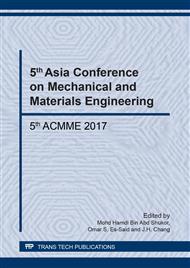p.106
p.111
p.116
p.122
p.127
p.133
p.145
p.151
p.157
Bending Behavior and Electrical Conductivity of Cu/Ni/Al/Ni/Cu Clad Composite
Abstract:
In this study, electro nickel coating was applied and its effect on the electrical conductivity and mechanical properties was investigated in Cu/Ni/Al/Ni/Cu clad composite after annealing at various temperature. After annealing at 300OC for 3hrs, the interface reaction layer at the Cu/Al interface was observed to be 3μm and no reaction layer was observed at the Ni/Al interface. After annealing above 400OC for 3hrs, the interface reaction layer at the Cu/Al interface in the absence of Ni layer was observed to grow more rapidly with increase of annealing temperature compared to that at the Ni/Al interface. The electrical conductivity increased after annealing up to 300OC for 3 hrs. possibly because of enhanced interface bonding and the recovery in the matrix. However, it was deteriorated after annealing above 400OC for 3 hrs. because of the formation of interface intermetallic. The more localized bending in the as-roll-bonded clad composite and that annealed at 200°C can be attributed to the near-zero and negative hardening rate in bending over the whole displacement. In this case, once bending occurs, bending continue to occur in the localized region because the work hardening due to the localized bending is negligible, leading to the localized fracture.
Info:
Periodical:
Pages:
127-132
Citation:
Online since:
November 2017
Authors:
Keywords:
Price:
Сopyright:
© 2017 Trans Tech Publications Ltd. All Rights Reserved
Share:
Citation:


